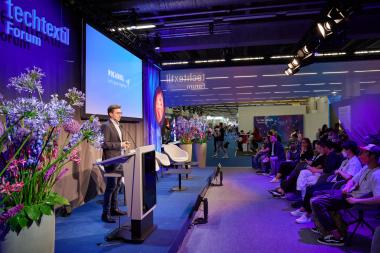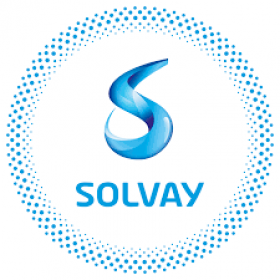Techtextil und Texprocess mit starkem Wissensprogramm
Wie hilft KI in der Textilindustrie? Was tut sich im Bereich Recycling und Kreislaufwirtschaft? Von Nachhaltigkeit bis Digitalisierung sind es die großen und dringenden Themen, die die Leitmessen Techtextil und Texprocess mit ihrem Rahmenprogramm angehen: Die Techtextil- und Texprocess Foren stehen auch 2024 wieder für Content, Speaker*innen und Networking und so zu Plattformen für Wissenstransfer, fachlichen Austausch und Business-Anbahnung.
Techtextil Forum: Von AI bis Zirkularität
Digitalisierung, Nachhaltigkeit, Lieferketten, alternative Materialien, Prozessoptimierung und Kreislaufwirtschaft: Was sind die neuesten Forschungsergebnisse, Technologien und Innovationen? Welche Trends und Lösungsansätze treiben die globale Textilbranche? Dazu bietet das Techtextil Forum an vier Tagen rund 50 Vorträge und Diskussionsrunden. Das Programm reicht dabei von A wie AI bis Z wie Zirkularität: Ricardo Vega Ayora (ITA Academy, Aachen) zeigt auf, wie künstliche Intelligenz gezielt für die Energie-Optimierung eingesetzt werden kann. Über ihren besonderen Durchbruch bei organischen Farbstoffen berichten Sophia Merve Ince und Dr. Recep Karadağ von Anatolian Colours. Textile Lösungen für die Zukunft liefern Moderator Dr. Jan Laperre (Centexbel) und Lea Zimmermann (DITF). Sie diskutieren, welche lebenswichtige Rolle Textilien im Kontext des Klimawandels übernehmen können und beleuchten ein aktuelles Forschungsprojekt zu energiefrei selbstkühlenden Textilien. Ein starker Schwerpunkt des Techtextil Forums liegt auf dem Feld Recycling. Dazu teilen unter anderem Johannes Leis (Sächsisches Textilforschungsinstitut) und Robin Oddon (Techtera) ihre Erkenntnisse in der Entwicklung von Kreislaufprozessen für die Bewirtschaftung von Verbundstoffabfällen und Abfällen. Lorenza Gardella (XLANCE) zeigt auf, welche Recyclingmöglichkeiten elastische Fasern auf Polyolefinbasis für neue Textilien eröffnen.
Texprocess Forum und Denim Talks: Zukunftsfähige nachhaltige Lösungen und Technologien stehen im Fokus. Content-Partner ist unter anderem der Verband Deutscher Maschinen- und Anlagenbau (VDMA Textile Care, Fabric and Leather), der von hier aus auch seine geführten Messerundgänge zu den Themen Digitalisierung und AI startet. Auf der Bühne diskutieren unter anderem im Econogy-Talk, co-hosted by VDMA, Federica Giachetti (Morgan Tecnica), Michael McDonald (SPESA) und Günter Veit (VEIT Group) darüber, wie Nachhaltigkeit mithilfe von technologischen Neuerungen implementiert werden kann.
Bei den Denim Talks laden Branchenexpert*innen dazu ein, die Zukunft der Denim-Industrie neu zu erleben. Besucher*innen erhalten Einblicke in zirkuläre Strategien und neue Verarbeitungstechnologien, treffen innovative Anbieter*innen und Akteure. Das Themenspektrum umfasst nachhaltige Ansätze für die Bereiche Washing, Destroying, Bleaching, Lasering, Dyeing, Re- und Upcycling oder Customizing. Mit dabei ist unter anderem Abdul Jabbar Athar (US Apparel & Textiles) mit seinem Vortrag „Denim Sustainability - A Nexus Approach“ sowie Enrico Cartabbia (MACPI Americas), der über die neuesten Innovationen für die Denim-Veredelung referiert.
Messe Frankfurt













